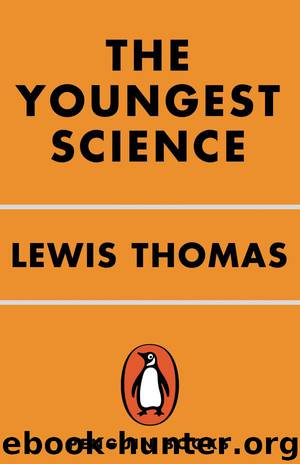The Youngest Science by Lewis Thomas

Author:Lewis Thomas
Language: eng
Format: epub
Publisher: Penguin Publishing Group
Published: 1995-05-02T00:00:00+00:00
13
THE BOARD OF HEALTH
Before I went to medical school my knowledge of the public health profession was limited to the childhood singsong: “Marguerite, go wash your feet, the Board of Health is down the street.” I learned very little about public heath in medical school, beyond what was called “The Sanitary Survey,” a required field study in the summer between the third and fourth years, in which all students were assigned in pairs to a municipal or county health department as observers. I had a classmate friend who lived in Cincinnati, and we arranged to survey that city. It took two weeks to do and another week to write a report. We learned more than we had known about sewage disposal, water bacteriology, venereal disease clinics, premarital Wassermann tests, and public baths, but it seemed a long way from medicine, a longer way from science. That was the extent of my training until I was appointed in 1956 as a member of the Board of Health of the City of New York, on which I served for fifteen years.
The New York Board of Health is the oldest such body in the country, having been organized in 1866 to deal with the epidemics of cholera and yellow fever then plaguing the city. It was statutorily set up as a separate legislative institution, empowered to write its own laws relating directly to matters of public health in the city; these laws comprise what used to be called the Sanitary Code, now known as the Health Code. The board is made up of five members—the commissioner of health, three physicians, and one layman.
I was appointed to the board to succeed Dr. Thomas Rivers of the Rockefeller Institute, who had just retired. The other members were Dr. Haven Emerson, representing public health, Dr. Samuel Z. Levine, then professor of pediatrics at the Cornell medical school, and Chester Barnard, head of the American Telephone and Telegraph Company. Later on, Louis Loeb, a lawyer in Manhattan, Dr. Walsh McDermott, professor of public health at Cornell, and Paul Hays, professor of law at Columbia, became board members. For most of the fifteen years of my service on the board, Dr. Leona Baumgartner was the health commissioner.
At about the time I became a member, the Board of Health, and the city’s health department itself, began to run out of things to do. Long before, in the last quarter of the nineteenth century and the early years of the twentieth, the New York City Department of Health had set the style and pace for other American city and state health departments, and its record of accomplishment and innovation was long and distinguished, but now, in 1956, the major problems of public health which had engaged the energies of the department for so many years seemed to have been solved. Tuberculosis had become a relatively uncommon disease, and the formerly elaborate measures for case finding and tracking people in contact with active cases were no longer needed. Syphilis and gonorrhea
Download
This site does not store any files on its server. We only index and link to content provided by other sites. Please contact the content providers to delete copyright contents if any and email us, we'll remove relevant links or contents immediately.
Hit Refresh by Satya Nadella(8346)
When Breath Becomes Air by Paul Kalanithi(7276)
The Girl Without a Voice by Casey Watson(7273)
Do No Harm Stories of Life, Death and Brain Surgery by Henry Marsh(6343)
A Court of Wings and Ruin by Sarah J. Maas(6119)
Hunger by Roxane Gay(4237)
Shoe Dog by Phil Knight(4185)
Everything Happens for a Reason by Kate Bowler(4076)
A Higher Loyalty: Truth, Lies, and Leadership by James Comey(4042)
The Rules Do Not Apply by Ariel Levy(3915)
Tuesdays with Morrie by Mitch Albom(3843)
The Immortal Life of Henrietta Lacks by Rebecca Skloot(3834)
How to Change Your Mind by Michael Pollan(3690)
Millionaire: The Philanderer, Gambler, and Duelist Who Invented Modern Finance by Janet Gleeson(3576)
All Creatures Great and Small by James Herriot(3528)
Elon Musk by Ashlee Vance(3463)
Tokyo Vice: An American Reporter on the Police Beat in Japan by Jake Adelstein(3447)
Man and His Symbols by Carl Gustav Jung(3330)
The Money Culture by Michael Lewis(3293)
